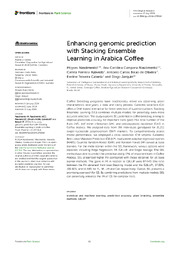Enhancing genomic prediction with stacking ensemble learning in arabica coffee.
Enhancing genomic prediction with stacking ensemble learning in arabica coffee.
Autoria: NASCIMENTO, M.; NASCIMENTO, A. C. C.; AZEVEDO, C. F.; OLIVEIRA, A. C. B. de; CAIXETA, E. T.; JARQUIN, D.
Resumo: Coffee Breeding programs have traditionally relied on observing plant characteristics over years, a slow and costly process. Genomic selection (GS) offers a DNA-based alternative for faster selection of superior cultivars. Stacking Ensemble Learning (SEL) combines multiple models for potentially even more accurate selection. This study explores SEL potential in coffee breeding, aiming to improve prediction accuracy for important traits [yield (YL), total number of the fruits (NF), leaf miner infestation (LM), and cercosporiosis incidence (Cer)] in Coffea Arabica. We analyzed data from 195 individuals genotyped for 21,211 single-nucleotide polymorphism (SNP) markers. To comprehensively assess model performance, we employed a cross-validation (CV) scheme. Genomic Best Linear Unbiased Prediction (GBLUP), multivariate adaptive regression splines (MARS), Quantile Random Forest (QRF), and Random Forest (RF) served as base learners. For the meta-learner within the SEL framework, various options were explored, including Ridge Regression, RF, GBLUP, and Single Average. The SEL method was able to predict the predictive ability (PA) of important traits in Coffea Arabica. SEL presented higher PA compared with those obtained for all base learner methods. The gains in PA in relation to GBLUP were 87.44% (the ratio between the PA obtained from best Stacking model and the GBLUP), 37.83%, 199.82%, and 14.59% for YL, NF, LM and Cer, respectively. Overall, SEL presents a promising approach for GS. By combining predictions from multiple models, SEL can potentially enhance the PA of GS for complex traits.
Ano de publicação: 2024
Tipo de publicação: Artigo de periódico
Unidade: Embrapa Café
Palavras-chave: Coffea Arábica, Genetic traits, Genomics, Plant breeding
Observações
1 - Por padrão são exibidas publicações dos últimos 20 anos. Para encontrar publicações mais antigas, configure o filtro ano de publicação, colocando o ano a partir do qual você deseja encontrar publicações. O filtro está na coluna da esquerda na busca acima.
2 - Para ler algumas publicações da Embrapa (apenas as que estão em formato ePub), é necessário ter, no celular ou computador, um desses softwares gratuitos. Sistemas Android: Google Play Livros; IOS: iBooks; Windows e Linux: software Calibre.
Acesse outras publicações
Acesse a Base de Dados da Pesquisa Agropecuária (BDPA) para consultar o acervo completo das bibliotecas da Embrapa.

